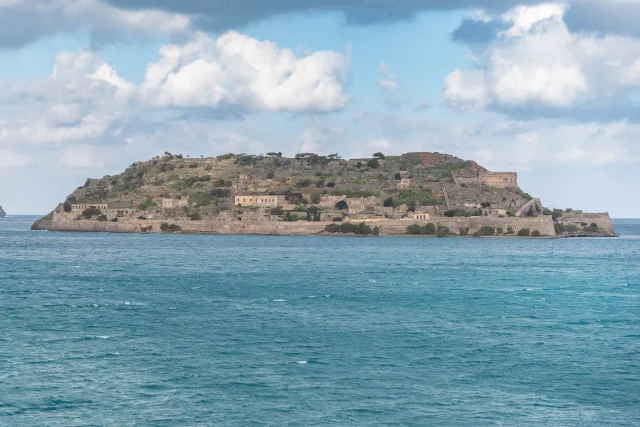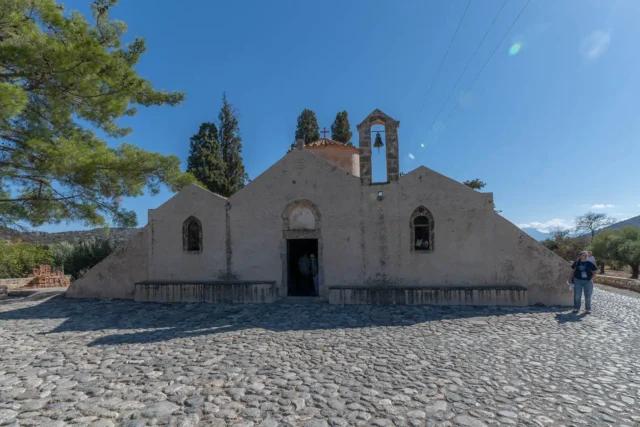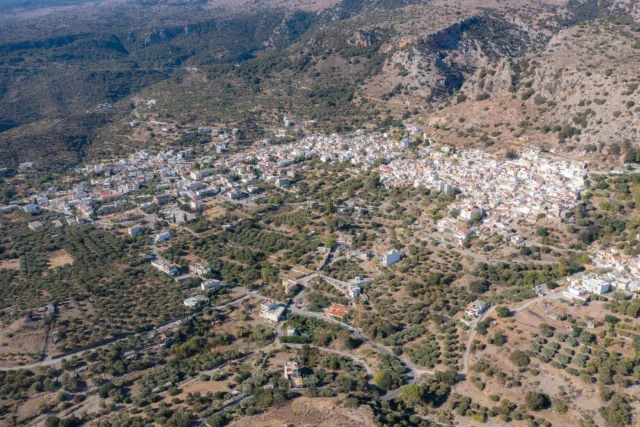24
listings found
Categories
Active filters:
Spinalonga
This rocky islet in the Gulf of Elounda, Lasithi (officially Kalydon), was a Byzantine watchtower linked to ancient Olous. The Venetians built it into a formidable sea fortress (1574-1586) which became their last stronghold, falling in 1715. It then became a thriving Ottoman commercial settlement, the largest Muslim center in the Mirabello region, until 1903. From 1903 to 1957, it was repurposed as a leper colony, a place of exile where patients formed a unique community, notably the "Brotherhood of Patients" (1936). Today, it is a protected archaeological site and on UNESCO's tentative list.
Gaidourophas
Gaidourophas, a Minoan archaeological site in Crete, features a two-story building with evidence of large-scale storage and administration. It's a significant node in the network of Minoan mountain sites.
The Archaeological Museum of Agios Nikolaos
The Archaeological Museum of Agios Nikolaos, Crete, houses a remarkable collection of artifacts spanning from the Neolithic period to the end of the Greco-Roman era. Established in 1970, the museum showcases the evolution of art and culture in Eastern Crete. The collection includes finds from the Early Minoan cemetery of Agia Fotia and the Minoan palace of Malia. One of the most renowned objects is the "Goddess of Myrtos," a unique libation vessel from the Pre-palatial period. The museum's rectangular building features eight exhibition halls arranged around a central atrium, facilitating a clear and intuitive flow for visitors. The museum actively engages with the public through temporary exhibitions and educational programs. It is open from 08:30 to 15:30, closed on Tuesdays. Ticket prices vary depending on the season, with combined tickets available for multiple archaeological sites and museums in the region.
Olous
Olous, an ancient Cretan harbor city, now largely submerged off the coast of Elounda, was inhabited from the Early Minoan period through the Hellenistic period. Its strategic location in the Mirabello Gulf made it a significant maritime hub, connecting the Eastern and Western Mediterranean. Archaeological investigations, including underwater surveys, have revealed remnants of Minoan cemeteries, fortifications, and possible public buildings. The city's history is intertwined with that of other Cretan powers like Knossos and Lato. Olous was known for its temple to Britomartis and its connections with Ptolemaic Egypt. Today, the site offers a glimpse into Crete's rich maritime past.
Mardati, Agios Nikolaos
Mardati is a settlement located in the Lasithi regional unit on the island of Crete, Greece. It belongs to the Municipality of Agios Nikolaos
Voulismeni, Agios Nikolaos
Voulismeni is a settlement located in the Lasithi regional unit on the island of Crete, Greece. It belongs to the Municipality of Agios Nikolaos
Vrachasi, Agios Nikolaos
Vrachasi is a settlement located in the Lasithi regional unit on the island of Crete, Greece. It belongs to the Municipality of Agios Nikolaos
Dreros, ancient city
Dreros, also known as Driros, is an archaeological site near Neapoli in Crete, significant for its post-Minoan remains from the early Archaic Period. Flourishing from the 8th to 6th centuries BC, Dreros was an important center of trade and culture, known for its harbor, temples, bronze working, and pottery. The city, built on two hills, features a sanctuary dedicated to Apollo Delphinios, where 8th century BC bronze statuettes of Apollo, Artemis, and Leto were discovered. A large, open cistern, possibly used for ritual purposes, was found in the agora, the city's public gathering space. Inscriptions reveal a board of officials called the 'Twenty of the Polis' and the division of the people into 'phylai' or tribes. The site includes one of the earliest known examples of a Greek temple, dedicated to Apollo Delphinios. Dreros declined in importance after the 6th century BC and was eventually abandoned.
Agios Ioannis Theologos in Kritsa
Located between Kritsa and Kroustas in Crete, this settlement centers on the Monastery of Agios Ioannis Theologos, founded in the 10th century during the Second Byzantine period. Mentioned in a 1219 treaty, its fortified location served as a crucial refuge for rebels ("hainides") against the Venetians and Ottomans. In 1925, its cells were given to Asia Minor refugees. The monastery's katholikon is a triple-aisled basilica with a dome, featuring valuable Byzantine frescoes dated 1347-1348. The naves are dedicated to the namesake, the Metamorphosis tou Sotira, and Agios Charalambos. A 13th-century silver processional cross from the monastery is now housed in the Historical Museum of Crete.
Panagia Kera in Kritsa
A three-aisled, vaulted Byzantine church near Kritsa, Lasithi, with a central dome. The aisles are dedicated to the Dormition of the Theotokos, Saint Anna, and Saint Anthony. Initially built in the Byzantine era, it was renovated in the 14th century, acquiring new frescoes in a Palaiologan style, and again in the 16th century. The interior contains two layers of frescoes from the 13th and 14th centuries, depicting the Christological Cycle, the Second Coming, and a rare image of Saint Francis.
Ancient Lato
Lato, an ancient city in Crete, reached its peak after the Dorian arrival. Named after the goddess Leto, Lato was strategically located on a hilltop overlooking the Mirabello Gulf. The city was heavily fortified, with strong walls, gates, and towers. Lato was one of the most powerful city-states in ancient Crete, with a well-organized political structure and a thriving economy. The city's port, Lato pros Kamara, facilitated trade and contributed to its growth. The archaeological site of Lato features well-preserved remains, including the agora, prytaneion, theater, temples, and private houses. Lato was eventually abandoned in the Roman era but was rediscovered in the late 19th and early 20th centuries. Today, it is a popular tourist destination, offering visitors a glimpse into the life of an ancient Cretan city. Lato was the birthplace of Nearchus, a famous admiral who served under Alexander the Great.
Choumeriakos, Agios Nikolaos
Choumeriakos is a settlement located in the Lasithi regional unit on the island of Crete, Greece. It belongs to the Municipality of Agios Nikolaos
Latsida, Agios Nikolaos
Latsida is a settlement located in the Lasithi regional unit on the island of Crete, Greece. It belongs to the Municipality of Agios Nikolaos
Vrysses, Agios Nikolaos
Vrysses is a settlement located in the Lasithi regional unit on the island of Crete, Greece. It belongs to the Municipality of Agios Nikolaos
Limnes, Agios Nikolaos
Limnes is a settlement located in the Lasithi regional unit on the island of Crete, Greece. It belongs to the Municipality of Agios Nikolaos
Fourni, Agios Nikolaos
Fourni is a settlement located in the Lasithi regional unit on the island of Crete, Greece. It belongs to the Municipality of Agios Nikolaos
Nikithianos, Agios Nikolaos
Nikithianos is a settlement located in the Lasithi regional unit on the island of Crete, Greece. It belongs to the Municipality of Agios Nikolaos
Kroustas, Agios Nikolaos
Kroustas is a settlement located in the Lasithi regional unit on the island of Crete, Greece. It belongs to the Municipality of Agios Nikolaos
Kritsa, Agios Nikolaos
Kritsa is a settlement located in the Lasithi regional unit on the island of Crete, Greece. It belongs to the Municipality of Agios Nikolaos










